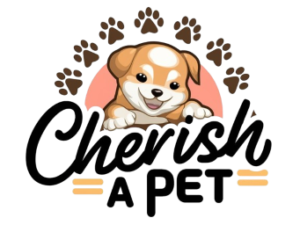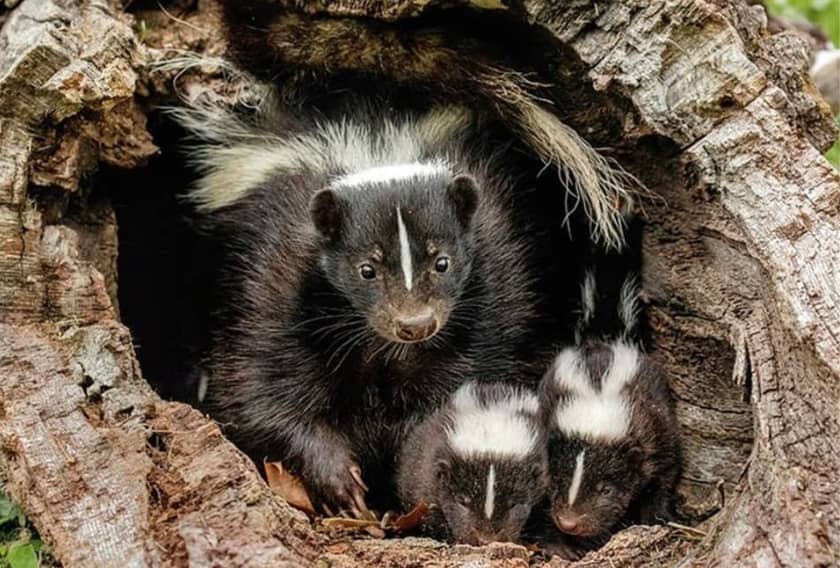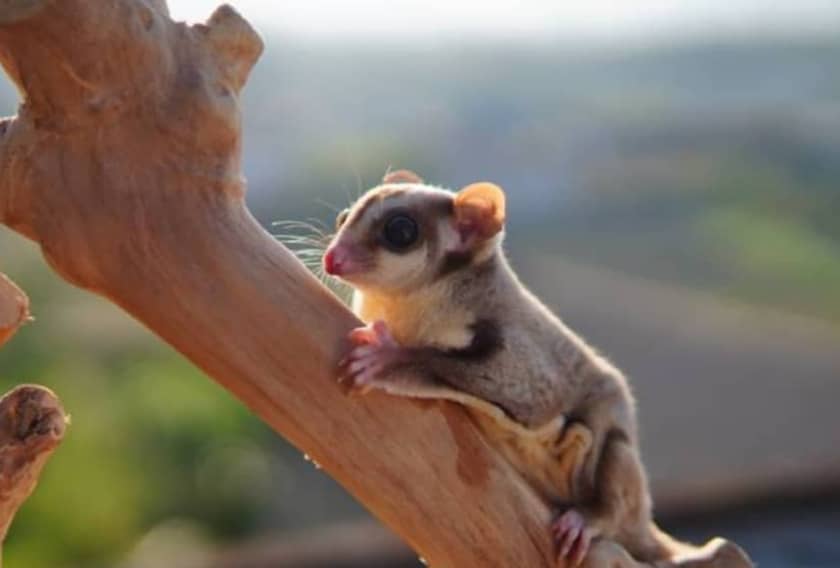The red giant flying squirrel, or common giant flying squirrel (Petaurista petaurista), is one of the largest species of flying squirrels, native to Southeast Asia. These nocturnal creatures glide between trees using a special membrane called the patagium.

They are known for their reddish-brown fur, large size, and ability to glide long distances. They primarily eat fruits, nuts, and leaves, playing a crucial role in spreading seeds throughout their forest habitats. While they are fascinating animals, they are rarely kept as pets due to their special needs and large size.
Male vs Female
Male and female red giant flying squirrels are very similar in appearance, with no major differences in size or color. However, females are responsible for raising the young and tend to be more protective during the breeding season. Males do not participate in nurturing the offspring.
Physical Appearance and Size Information
The red giant flying squirrel is large, with a head and body length of 28.5–55 cm and a tail length of 34–63 cm. They weigh between 2 and 3 pounds, making them one of the largest species of flying squirrels. The red giant flying squirrel is dark reddish-brown on top and light orangish-brown to buff on the bottom. It has black rings around its eyes and near its nose. The tail of red giant flying squirrels is reddish-brown or orangish-brown with a black top.
The red giant flying squirrel has a membrane of skin between its legs and arms that allows it to glide between trees.
The red giant flying squirrel has large eyes, which help it see well at night since it is nocturnal. These big eyes are perfect for navigating through the dark forests while gliding between trees.
Diet and Nutrition
The red giant flying is an herbivore; they are mainly plant eaters, feeding on fruits, nuts, leaves, and tree bark. Occasionally, they might eat small insects or bird eggs. These squirrels are active at night, gliding through the trees to find food. Their plant-based diet gives them the energy they need to stay active and healthy. Eating a variety of fruits and nuts also helps spread seeds, which helps trees grow.
Behavior and Temperament
Red giant flying squirrels are most active at night, starting their activity just before dusk and retreating at dawn. They may sometimes stay out until midmorning. They are solitary animals and good climbers. While gliding, red giant flying can control the direction of their glide by tensing and relaxing their membrane muscles.

They are threatened by the destruction of their habitat, due to logging, agriculture, dam construction, infrastructure development, and urbanization.
Care
Caring for a red giant flying squirrel is challenging due to its specialized needs. They require a large, naturalistic habitat with plenty of room to glide. Additionally, they need a diet rich in fruits, nuts, and leaves similar to what they would find in the wild. Their care involves maintaining a proper diet, exercise, and housing setup that mimics their natural environment.
Housing Requirements
These squirrels need a large, vertical enclosure with plenty of trees, branches, and platforms to glide and climb. The enclosure should be at least 8-10 feet high and provide enough space for the squirrel to move freely. A temperature-controlled environment is necessary to thrive in warm, humid conditions.
Gliding Abilities
The red giant flying squirrel usually travels between trees by long glides, up to at least 100-150 m (330-490 ft). It has a special flap of skin that stretches from its front to back legs, which it uses like wings. When it jumps, it spreads its legs to catch the air and glide smoothly. The squirrel can steer and change direction using its tail, helping it move easily through the trees to find food and stay safe from predators.

Feeding
The red giant flying squirrel is an herbivore; they primarily feed on fruits, nuts, leaves, and tree bark. It’s mostly active at night, gliding through the trees to find food. Occasionally, it may also eat small insects or bird eggs. This varied diet helps the squirrel get all the nutrients it needs to stay healthy and active.
Social life and breeding
The Red Giant flying squirrel is generally a solitary animal, meaning it prefers to live alone rather than in groups. However, during the breeding season, males and females will come together to mate. Breeding usually happens once or twice a year. After meeting, the female builds a nest high in the trees, where she gives birth to one or two babies. The mother takes care of the young squirrels until they are old enough to glide and find food on their own. once they are independent, they leave the nest and live on their own.
Exercise
Exercise is vital for their health. Red Giant Flying Squirrels need space to glide and climb, so their enclosure must allow for free movement. Provide plenty of trees, branches, and platforms for climbing and gliding. In captivity, they may need supervised time outside their enclosure to ensure they remain active.
Handling
These squirrels are not suited for frequent handling. They are shy and can become stressed or frightened by human contact. If they are kept as pets, handling should be limited and done gently, if at all.
Related Species
- Northern flying squirrel
- Southern flying squirrel
- Humboldt’s flying squirrel
Health Issues
In captivity, Red Giant Flying Squirrels may suffer from malnutrition, stress, and a lack of exercise. Common health issues include:
Obesity (from lack of exercise)
Malnutrition (from an improper diet)
Stress-related behavior
Signs of Ill health
- Loss of appetite
- Lethargy or inactivity
- Hair loss or skin problems
- Difficulty gliding or climbing
- Unusual aggression or fearfulness
Interesting Facts
1. Red Giant Flying Squirrels can glide up to 330 feet.
2. They use their tail as a rudder while gliding
3. They are nocturnal and only come out at night.
4. They live high in the trees and rarely reach the ground.
5. They don’t hibernate
6. They play a crucial role in seed dispersal for trees.
7. They play a crucial role in seed dispersal for trees.
8. They are solitary creatures and prefer to live alone
9. These squirrels are one of the largest flying squirrel species.
10. Their gliding membrane (patagium) stretches from wrists to ankles.

Some Things You Never Knew About Red Squirrels
- They aren’t strictly red!
While the red squirrel is usually a lovely rusty color, in the winter, their coats fade to more of a brownish-grey. - They have a carnivorous side
Red squirrels are vegetarian, but they are known to eat small birds and their eggs. They are most known, however, for their love of nuts and favor forests where there is a good supply and variation. - They build their habitat
We like to call them red squirrels,” nature’s tree planters. They build up their nest high up in the trees, and they choose locations that are well-protected from predators and the elements. It’s common for a single squirrel to maintain multiple nests within its territory. - They don’t hibernate
Red flying squirrels do not hibernate because they live in tropical and subtropical forests where temperatures remain warm year-round. Unlike species in colder climates, these squirrels are active throughout the year, relying on the consistent availability of food like fruit, nuts leaves. - No ear tufts? No problem!
One sure giveaway that what you’re looking at is a red squirrel is usually its lovely ear tufts. However, during periods of molting, particularly at the end of the summer, they may temporarily lose these tufts. They do grow back though! - Not afraid to take a dip!
Although rarely seen, red squirrels can swim! 8 years ago, one was seen in the middle of Ullswater in the lake district, much to the surprise of tourists aboard a boat. The squirrel has swum out over 300 meters. - They have a fantastic grip on things
Red squirrels are very dexterous and are both right and left-handed. This is so they can hold and extract nuts and seeds as well as climb well through the tree canopy. They have four fingers and five toes on each paw and foot.
Frequently Asked Questions:
Question 1: What is the largest species of flying squirrel?
Answer: The red and white giant flying squirrel is the largest squirrel.
Question 2: What are the characteristics of the red giant flying squirrels?
Answer: It is a dark red color. The squirrel is found in South Asia, Southern China, Southeast Asia, northern India and Pakistan, java, and Taiwan. It eats fruit and nuts and, occasionally, insects.
Question 3: Where can you find red squirrels?
Answer: American red squirrels can be found throughout the United States in the forest of Alaska, the east coast north of Georgia, and the Rocky Mountains. The squirrels prefer coniferous forests.
Question 4: What do red giant flying squirrels eat?
Answer: The giant flying squirrel’s diet primarily consists of pine cones, tree buds, leaves, young branches, and when in season, various fruits, nuts, and anything else with sufficient nutritional value.
Question 5: What is the real name of red squirrels?
Answer: The real name of the red giant flying squirrel is Sciurus vulgaris. It’s a scientific name, and it refers specifically to this large species of flying squirrel found in the forest of Southeast Asia.
Question 6: Are red giant flying squirrels aggressive?
Answer: Red giant flying squirrels are generally shy and not aggressive.
Question 7: How can we save a red giant flying squirrel?
Answer: We can help to restore their populations and promote biodiversity. It is essential to provide wildlife services and protected areas where animals can thrive without human interference.
Pros and Cons of Keeping a Red Giant Flying Squirrel as a Pet:
A flying squirrel can be kept as a pet, but it is a very high-maintenance animal. You should know every plus and minus of keeping a red giant flying squirrel as a pet. Another thing is that squirrels bite. They bite very, very hard and can even hit bone. Flying squirrels are wild animals, and wild animals do not act or react like domestic animals.
Pros:
- Fascinating to observe due to their gliding behavior
- They are nocturnal and quiet.
Cons:
- Expensive and difficult to care
- Requiring a very large space to glide
- Not suitable for frequent handling
- It may be illegal to own in some areas
Conclusion:
The red giant flying squirrels are fascinating and adorable creatures but thrive in their natural habitat. They are high-maintenance and have specific requirements.


